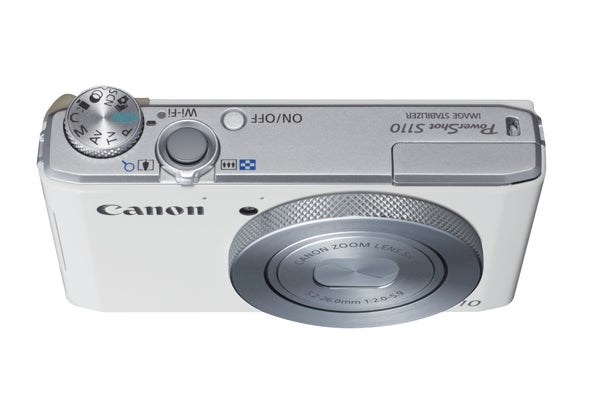Canon PowerShot S110 Review
Canon PowerShot S110
Canon's latest advanced compact delivers great image quality and responsive touch-screen control.

Verdict
Pros
- Excellent image quality
- Solid construction and improved design
- Good handling and performance
- Worthwhile additions to specification
Cons
- Not the cheapest model on the market
- Wi-Fi functionality lags behind some of its rivals
Key Specifications
- Review Price: £430.00
- 1/1.7in 12.1MP CMOS HS sensor
- Canon DIGIC 5 image processor
- ISO 80 - 12,800
- 5x optical zoom (24-120mm equiv.)
- 1080p Full HD movie recording at 24fps
- 3in, 461k-dot touch-screen LCD
Canon PowerShot S110: Introduction
Advanced compacts have become an increasingly popular choice for those photographers looking for a camera that’s small enough to be carried around all day without weighing you down, but which also offers the added functionality and greater degree of user control offered by DSLRs. 
With the launch of the S90 in 2009 Canon had this segment of the compact market pretty much to itself, with only the Panasonic Lumix LX3 really offering it any serious competition. Fast-forward three years and the advanced compact market is much more crowded, with all of the major manufacturers now offering at least one model of their own. Indeed, in the past 12 months we’ve seen the likes of the Fuji X10, the Nikon P310, the Nikon P7700, the Samsung EX2F, the Lumix LX7 and the Sony RX100 all burst on to the scene, each bringing with it an added competitive edge. Has the PowerShot S110 got what it takes to compete? Let’s take a closer look and find out.
Canon PowerShot S110: Features
The Canon PowerShot S110 succeeds the S100 that was released about this time last year. The S110 retains all of the advanced operational and shooting features of its predecessor; the customisable control ring remains in place around the base of the lens, as does the ability to take full manual control over the camera and shoot in Raw should you wish. This being a new model, there are of course a host of new features too, the most notable of which are the additions of touchscreen functionality along with a Wi-Fi connectivity. More on those in a moment, but first let’s have a look at the other headline specs to see what’s changed from the S100.
Put simply, internally the S110 doesn’t represent a huge upgrade over the S100. Indeed it’s really more of a gentle refresh with the newer model employing the same 1/1.7in 12.1MP High Sensitivity (HS) CMOS sensor and DIGIC 5 image processor found inside the S100. That’s not to do the combination down in any way, as the S100 was (and remains) more than capable of excellent image quality.
Sensitivity ranges from a baseline ISO 80 up to 12,800 – making the S110 a stop faster than the maximum ISO 6400 setting of its predecessor. Canon’s proprietary High Sensitivity system (which is essentially just the name given to the pairing of the S110’s advanced CMOS sensor and DIGIC 5 image processor) also promises to reduce the effects of obtrusive image noise at higher ISO settings. The DIGIC 5 processor also facilitates the S110’s High-speed Burst mode of up to 10fps, although only to a maximum of 10 consecutive frames.
On the front of the new model the S110 gets the same 5x fixed zoom that’s found on the S100. This offers the 35mm focal range equivalent of 24-120mm, which should be flexible enough to cover most day-to-day situations – just so long as your subject isn’t too far away in the distance. Maximum aperture is a usefully quick f/2 at 24mm, but disappointingly this drops to a not particularly quick f/5.9 by the time you reach 120mm. Indeed compared to rivals such as the Lumix LX7 (f/1.4-2.3), Samsung EX2F (f/1.4-2.7), Olympus XZ-2 (f/1.8-2.5), Fuji X10 (f2-2.8), Sony RX100 (f/1.8-4.9) and Nikon P310 (f/1.8-4.9) the Canon S110’s lens actually comes up a bit short – at least in terms of speed. The lens does however benefit from what Canon claims to be a 4-stop intelligent IS system, which is designed to minimise the effects of camera shake at slower shutter speed and longer focal lengths.
In addition to Program, Aperture-priority, Shutter-priority and Manual (PASM) exposure modes, the S110 also offers a Smart Auto automatic scene recognition mode alongside a host of individually selectable Scene modes for simplified point-and-shoot operation. In addition, the camera also benefits from a range of Creative Filter digital effects modes that include all the regular favourites such as Fish-eye, Miniaturisation, Toy Camera and Colour Swap among others.
In addition to its still imaging capabilities, the S110 also offers 1080p Full HD video capture at 24fps with sound recorded in stereo via two microphones positioned on the front of the camera. In addition to Full HD capture, the S110 also allows you to capture 720p HD and 640 x 480 VGA quality movies. Last but not least are a couple of high-speed movie capture modes – 640 x 480 at 120fps, and 320 x 240 at 240fps – both of which will play back in slow motion.
Two areas where Canon has upgraded the S110 in order to keep it more competitive are with the additions of touch-screen functionality and Wi-Fi connectivity. The former employs the S100’s otherwise unchanged 3in, 461k-dot screen and uses capacitive touchscreen technology to add a new layer of control over the camera. The touch-screen is able to recognise a range of gestures – such as pinch-to-zoom – as well as the regular Touch AF and Touch Shutter features found in other touch-screen compacts.
Wi-Fi connectivity is quickly becoming the must-have feature for digital cameras, so it’s good to see that Canon have seen fit to include it here. That said, its actual implementation isn’t quite as complete as what’s found on some other Wi-Fi enabled compacts, however it still offers a range of functions that many photographers will no doubt find useful. With Wi-Fi enabled S110 users can share images online directly from the camera, as well as print directly from a Canon Wi-Fi enabled printer. In addition, the S110 can also utilise a smartphone’s GPS to keep track of shooting locations and later synchronise this information to image metadata.
Canon PowerShot S110: Design
While the S110 remains close to the S100 internally, externally there have been a number of design tweaks, not least the removal of the finger grip and increased bevelling around the edges. The thumb grip on the back is more pronounced too, with a longer ridge running down the side that helps to keep your thumb from slipping off the camera. 
Small it might be, but the S110 undoubtedly feels like a serious bit of kit. Improvements have also been made to the three main control points – the mode dial on the top plate, the control ring that surround the base of the lens and the function dial on the camera’s rear all feel sturdier and less prone to accidental nudges than before, with a satisfying ‘click’ as you rotate them.
The pop-up flash that’s housed inside the left-hand shoulder (as you look at the camera from the back) has also been re-engineered. The button that was used to pop the flash up on the S110 has been removed and the flash is now motorised instead and will automatically raise itself with a pleasingly smooth whir when the flash mode ‘on’ position is selected via the D-pad controls, or indeed when the camera is being used in Automatic mode and flash is deemed to be necessary. 
Canon PowerShot S110: Performance
As with previous PowerShot S series cameras, build quality is very high indeed with the S110 feeling every inch the premium camera it’s positioned as. Furthermore, certain design elements go beyond the merely cosmetic and actually help to improve the performance – or at least the operation – of the camera too. The best example of this is the front command dial. This rotating wheel is fully user customisable and can be set to control a range of camera functions from basic shooting parameters such as shutter or aperture settings, through to exposure compensation and ISO settings – all of which is exactly the kind of functionality you’d expect from an advanced compact.
In addition to the control wheel, the S110 also sports a new 3in capacitive touchscreen – a first for the PowerShot ‘S’ series. In use the touchscreen proves pleasingly sensitive to your fingers and also offers the same kind of ‘gesture-based’ functionality that smartphone users will be instantly familiar with. This includes the ability to swipe left and right in Playback mode in order to scroll through captured images, as well as pinch-to-zoom functionality and double-tapping to zoom out. 
The touch-screen also supports Touch Shutter and Touch AF – two intuitive technologies that can be really useful, especially for spur-of-the-moment candid photography when a point of focus is required quickly. Both function promptly and accurately, allowing you to quickly capture moments that might otherwise be lost while you’re busy fiddling about with buttons and control wheels to put the AF point in the correct place. Autofocus performance in general is pretty good too, with the S110’s 9-point contrast-detect AF system pleasingly zippy when used in adequate light.
Processing fares a little less well and there’s a noticeable delay when the camera is tasked with writing Raw files. It’s not so bad as to impinge on shot to shot speed when the camera is used in Single-shot drive mode however, as invariably the buffer has cleared by the time you’re ready to take the next shot. Switching over to Continuous drive mode, we found the S110 perfectly able to deliver the claimed maximum burst speed of 10fps at full-resolution, however it’s only able to capture 10 consecutive frames in this way before coming to a very swift and sudden halt, which does necessitate the need to time such bursts well.
Looking at Wi-Fi, we had no problems connecting the camera up to an available network and found it to perform perfectly well, although functionality is a little limited – especially compared to what some rival Wi-Fi enabled cameras currently offer. Functionality could certainly be improved through the ability to remotely operate the camera via a smartphone or tablet, or the ability to shoot tethered through the Wi-Fi functionality. Hopefully this is a feature that can be added at a later date.
Below are our standardised ISO test shots, starting with the Canon S110’s lowest standard setting of ISO 800 and rising incrementally to
the top setting of ISO 12,800.
ISO 100 – The test scene in full (click to enlarge)

ISO 80 – 100% crop

ISO 100 – 100% crop

ISO 200 – 100% crop

ISO 400 – 100% crop

ISO 800 – 100% crop

ISO 800 – full-size (click to enlarge)

ISO 1600 – 100% crop

ISO 3200 – 100% crop

ISO 3200 – full size (click to enlarge)

ISO 6400 – 100% crop

ISO 12,800 – 100% crop

ISO 12,800 – full size (click to enlarge)

1/125sec @ f/4.5, ISO 200

1/60sec @ f/2.8, ISO 100

1/1600sec @ f/2, ISO 80

1/60sec @ f/2, ISO 800

1/40sec @ f/2, ISO 800
Canon PowerShot S110: Image Quality
As with its predecessor, the S110 delivers a level of image quality that impresses across the board. JPEG images straight from the camera display rich tones and an even balance between shadows and highlights. In addition, the S110 also manages to retain good levels of detail in both shadow and highlights – even in when faced with tricky high-contrast scenes.
Metering proves consistent too, with the S110 very rarely getting things wrong in this regard. On the few occasions when it does, the S110 shows a slight tendency to underexpose rather than overexpose, which is thankfully generally much easier to fix in post-production.
The automatic white balance system proves as reliable as the metering module, and we’re pleased to report we didn’t experience any instances of images coming out artificially warm or cold.
One small criticism that could be levelled at the S110 is that colours tend to be fairly neutral with the My Colours processing presets switched off, however this is easily rectified by choosing an alternative preset: with 10 individual options (and a Custom setting) to choose from it shouldn’t be too hard to find something that suits your own personal taste.
Lens performance impresses too, and while the S110’s 24-120mm zoom might not provide quite enough telephoto reach for some, it keeps images impressively sharp throughout the entire zoom range. We did experience some slight issues with fringing on extreme contrast borders, although thankfully this wasn’t to the overall detriment of image quality.
Noise control is another area where the S110 performs well. At the lowest sensitivity settings, images are clean and sharp and while the middling to higher settings do show some signs of image noise creeping in, the S110 does a good jib of keeping it to a minimum. Even the highest available settings of ISO 6400 and ISO 12800 where fine detail does begin to suffer are far from unusable.
Canon PowerShot S110: Verdict
The Canon PowerShot S110 is a 12.1MP advanced compact that will most likely to appeal to enthusiast photographers looking for an easy-to-carry yet flexible compact companion. In this respect the S110 delivers on its remit, delivering impressive image quality – including the ability to shoot in Raw – a responsive touch-screen and full manual control, along with excellent build quality and built-in W-Fi. It’s not quite perfect though; compared to many of its rivals the S110’s 5x zoom is slow at the telephoto end, and while the integrated Wi-Fi connectivity certainly helps to give it the S110 competitive edge, its functionality isn’t quite as complete as with some competing models. That aside, if you’re looking for an enthusiascompact the Canon S110 certainly warrants consideration.
Trusted Score
Score in detail
-
Value 7
-
Design & Features 8
-
Image Quality 8
-
Build Quality 9

